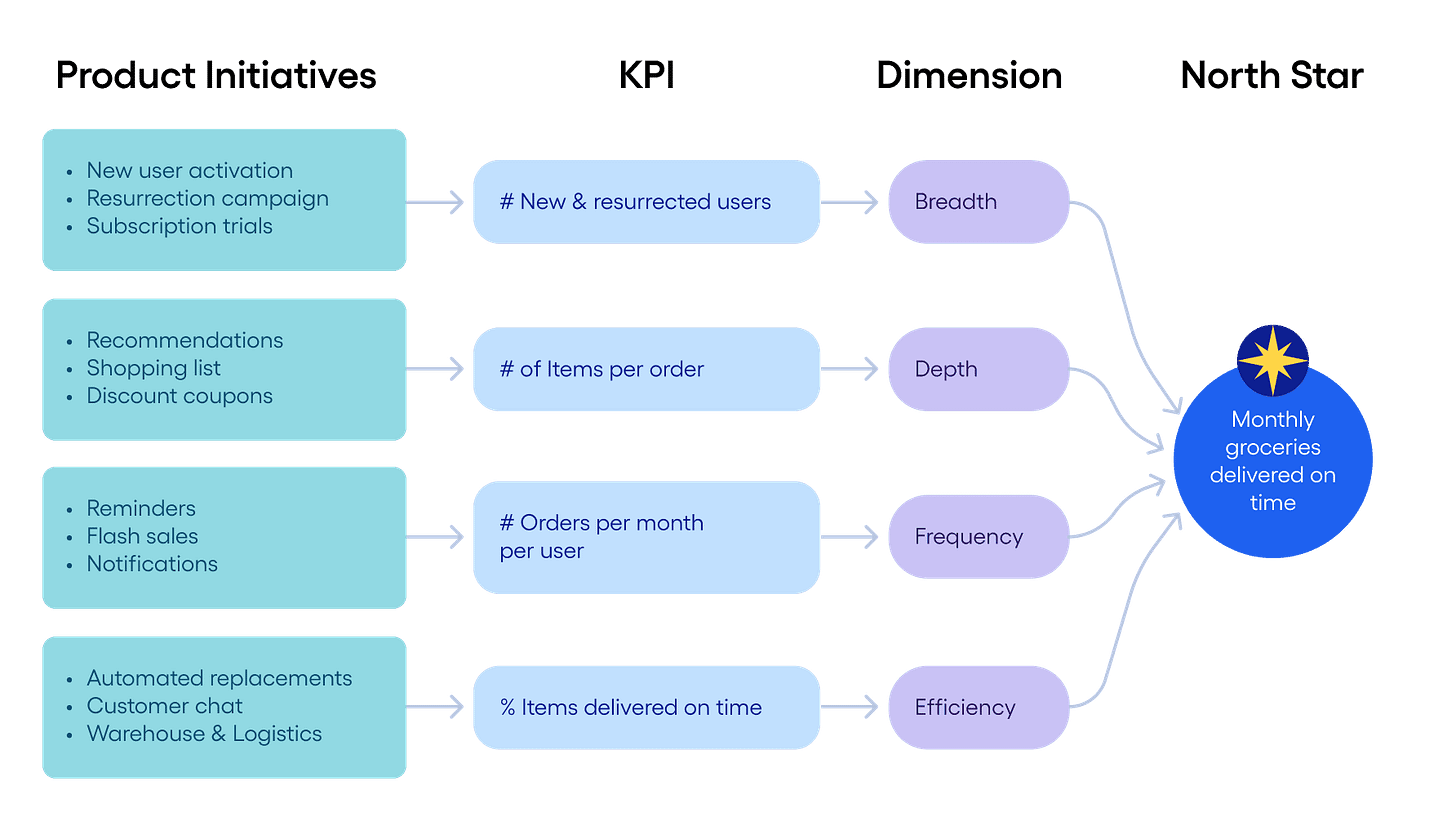An engineering lead in my organisation asked:
as a growth stage B2B business, we’re growing exponentially, and acquiring new customers and users →
in a world with a continuous and expanding flow of new users, our North Star metric would continue moving northwards →
so what’s the point of the metric? what are we really measuring, and how can we meaningfully use it?
To answer, let’s start by briefly understanding the North Star metric.
A metric is a measure of a system attribute. Metrics help make decisions.
Products and businesses needs metrics to identify whether a change is good, or bad for business.
The goal of any business is to make money. In the course of making money, businesses optimise for long-term profit. Short-term indicators of long-term profits are higher revenue, and market cap.
The problem with revenue as a metric is that it's lagging.
If you change something on your product, and the change makes your product more useful to your customers, depending on your business model it might take weeks, if not months, for the change to impact revenue. This makes it difficult to make revenue-driven product decisions.
North Star metric is a solution to this problem.
North Star Metric
A North Star metric is a single metric that reflects the core value your product delivers to customers and serves as a leading indicator of future revenue.
Examples of real-world North Star metrics:
All these metrics incorporate three things:
1. leading indicators of revenue
2. capture how the business is valuable to users
3. incorporate the product strategy (notice the DAU vs MAU difference between Facebook and LinkedIn)
A great North Star metric makes it possible to quantify and measure the success of a product. It also acts as a glue between different teams and functions by unifying the goal everyone chases.
The issue with a North Star metric is — when used in isolation, it is an over-simplification.
When different teams are optimising for the North Star metric, how do you truly isolate the impact of a change on the North Star metric?
Moreover, as the engineering lead pointed out, in growth stage companies, metrics are often booming due to new customer acquisitions — in a world of persistent growth, how do you identify the impact of what you're shipping on the usefulness of your product?
This is why you need to identify dimensions of your North Start metric.
Dimensions of a North Star Metric
Dimensions of a North Star metric are measurable components that contribute to the metric. They make a North Star metric actionable, by making it easier to isolate and measure the impact of changes.
I've listed commonly used dimensions below, but the dimensions you measure can vary based on how your product and business operates.
Acquisition: new user sign-ups on product
Activation: ratio of new users forming a habit of using product
Engagement: depth of usage of product in a session
Stickiness: frequency of product usage
Retention: ratio of users with sustained product usage over time
Resurrection: rate of re-activating dormant users
An increase in acquisition will likely bump your North Star metric. So would an increase in resurrection, engagement, and so on. Dividing the North Star metric into dimensions makes it possible to isolate and measure the impact of changes.
For example, if as a product manager, you change your product’s onboarding experience, it should move your activation metric. Which in turn should drive your North Star metric. If your activation metric remains flat after the change, and the North Star metric keeps rising, it’s not you. Changes in the North Star metric might be due to other product changes, or new user sign-ups.
Product changes are best measured by identifying, and tracking their impact on a dimension of the North Star metric.
So what's the point of a North Star Metric?
Coming back to the question we started with — so if the North Star metric itself can't be used to isolate impact and measure product changes, what's the point?
The point of a North Star metric isn’t to replace every other metric or to isolate the impact of specific product changes.
The point of a North Star metric is to empower teams to identify great dimension metrics that can pinpoint the impact of product changes, and tie them to revenue by showing the impact of moving the dimension on the North Star metric.
It also provides a unified goal that reflects how well the business is delivering value to customers, and provides a measure for the entire organisation to rally behind.

The key is understanding that the North Star metric doesn’t operate in isolation. It sets a clear direction for what matters most—customer value—while the dimensions of the North Star metric allow teams to dig deeper and measure the effects of specific changes.
A lot has been written on the North Star Framework and on defining North Star metrics, and I don’t intend to add to the noise. I do feel that the conversation around identifying dimensions of a North Star metric often does not get the due attention.
This creates a North Star metric that’s a leading indicator of revenue, but entirely disconnected from actual product development since it can’t be used to measure product initiatives.
This also creates distrust in the North Star metric, because well, what really does it measure when you can’t use it to track product initiatives?
Identify, and measure great dimensions today.

